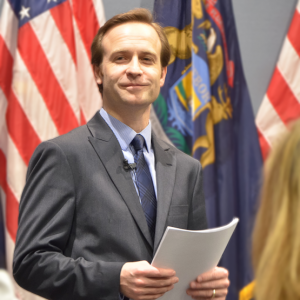 MIRS News Service report;
MIRS News Service report;
Gov. Rick SNYDER remained his relentless positive self this afternoon despite EPIC-MRA polling data released in the morning showing the May 5 ballot proposal losing 37 to 49 percent among “certain voters” when read a lengthy explanation on the plan.
“Isn’t a life more important than a dollar?” said Snyder, adding the internal polling data is “more positive” than the EPIC-MRA finding.
The EPIC-MRA survey asked 600 voters between Jan. 24-27 about the May 5 ballot proposal designed to improve Michigan’s road through a penny hike in the sales tax.
When initially presented to “certain” voters — as opposed to “likely” voters — 46 percent said they would support Proposal 1 while 44 percent say they would not.
However, once more detail about the plan is presented to them, support dropped to 37 percent and opposition grew to 49 percent. The margin of error was +/- 4.0 percent.
EPIC-MRA’s Bernie PORN said it may be because the Legislature and Governor loaded the ballot proposal with so many moving parts that a confused voting public is defaulting to voting no.
Porn said the ballot proposal has its strongest support in central Michigan (52 to 35 percent), followed by the Outer Metro Detroit region (50 to 40). It does the worst in Northern Michigan (58 to 37 percent).
Younger voters (aged 18-34) were more supportive (59 to 28 percent) than those aged 49-6, who opposed it 49 to 38 percent.
College educated voters liked it 49 to 39 percent while those with a high school diploma or less opposed it 47 to 38 percent. Women are voting “yes” 48 to 36 percent while all mean slightly opposed 46 to 44 percent.
The following information was read to survey respondents:
“Now I would like to read a more detailed statement about Proposal 1. Increasing the state sales tax from 6 to 7cents would raise about 1.6 billion dollars per year, with 1.3 billion dollars going to state road, street and bridge improvements; 300 million dollars per year in new increased funding going to local public schools, equal to about $200 per pupil; 112 million dollars going to mass transit services; and 95 million dollars in increased revenue sharing going to local governments. The sales tax increase would replace the 752 million dollars in revenue that currently goes to schools and local governments that has been generated by the existing 6 percent sales tax charged on gasoline at the pump, which would be eliminated. Also, the existing gas tax and diesel fuel tax would be replaced with a tax charged at the wholesale level, resulting in an estimated 3 cent per gallon gas tax increase above 2013 levels. Vehicle registration fees would increase by eliminating a 10 percent per year discount new car buyers receive for the first three years they own their cars, as well as increasing registration fees for hybrid and electric vehicles, which will raise an additional 45 million dollars. It will also increase annual fees for heavy commercial trucks by 50 million dollars. The Earned Income Tax Credit, which was reduced in 2011, would be fully restored; which will provide about $300 per year in tax relief for low-income families. Universities would no longer be funded from the state School Aid Fund, meaning funding from that source could only be used for local public schools and community colleges.”
If Proposal 1 were to pass, all current gasoline taxes would be scrapped for a new wholesale gasoline tax that would shift roughly $1.2 billion in new revenue to the roads. While drivers likely wouldn’t see a price difference with the new tax, they would see a one-cent higher sales tax (6 to 7 percent).
The proceeds of that additional penny would go to what the current sales tax on gasoline pays for — schools and local governments, in particular. The proposal also freezes annual driver registration fees, which is expected to raise $45 million and raises truck fees $50 million.
The proposal raises about an addition $300 million for schools, restores the Earned Income Tax Credit for the working poor and steers $40 million to “at-risk” schools, among other reforms.
Other Polling Data
– Other data from the EPIC-MRA poll shows 60 percent of respondents believe Michigan is headed in the right direction, which is up from 52 percent in December.
– 71 percent said Michigan’s economy has bottomed out and is now improving.
– Snyder has a 54 percent favorable ranking with 50 percent giving him a positive job ranking.


